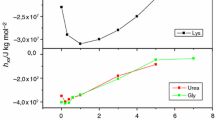Abstract
IT has been shown recently by Linderstrm-Lang and Ottesen1 that ovalbumin is transformed, by the action of a bacterial enzyme from Bacillus subtilis, into a protein that crystallizes as rectangular plates from ammonium sulphate. In an earlier paper2, MacPherson, Moore and Longsworth report that an ovalbumin component, A2 (characterized by its mobility in the electric field), increased at the expense of another one, A1, during storage of a salt-free, isoelectric solution under toluene. It therefore seemed of interest to compare the electrophoretic behaviour of the enzyme-modified ovalbumin with the A2 -form of the original protein.
Similar content being viewed by others
References
Linderstrøm-Lang, K., and Ottesen, M., Nature, 159, 807 (1947).
MacPherson, C. F. C., Moore, D. H., and Longsworth, L. G., J. Biol. Chem., 156, 381 (1944).
Sørensen, S.P. L., and Hoyrup, M., C.R. Lab. Carlsberg, 12, 12 (1917).
Cf. MâchebÅ"uf, M., Sørensen, M., and Sørensen, S. P. L., CM. Lab. Carlsberg, 16, No. 12 (1927).
Author information
Authors and Affiliations
Rights and permissions
About this article
Cite this article
PERLMANN, G. Electrophoretic Behaviour of Modified Ovalbumins. Nature 161, 720–721 (1948). https://doi.org/10.1038/161720b0
Issue Date:
DOI: https://doi.org/10.1038/161720b0
- Springer Nature Limited





